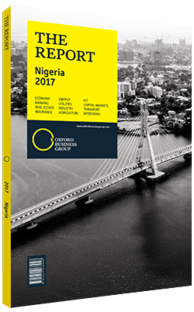International investment: How market trends are affecting foreign investment inflows
Nigeria was included in JPM organ’s Government Bond Index-Emerging Markets (GBI-EM) index series for local currency government bonds with effect from October 2012, with a 1.5% weighting, and was removed from it in September/October 2015. The inclusion followed the removal of the one-year lock-in period for foreign investors in government bonds by the Central Bank of Nigeria (CBN). This decision brought the sovereign market onto the radar of a wider range of international investors, in addition to the tracker funds. For several quarters the balance of payments (BoP) showed gross portfolio inflows of more than $5bn, mostly from fixed-income players. Our chart on investment flows shows the latter stages of the surge. The offshore community held up to 15% of the stock of naira-dominated Federal Government of Nigeria (FGN) bonds.
Fallout
Most foreign investors had exited the market before Nigeria’s formal removal from the index series. Foreign exchange (FX) had become scarce to the point that many investors had to join a queue to make their exit. The offshore share of FGN bonds plummeted towards zero. JPM organ acted in response to the CBN’s administrative measures and the absence of a fully functioning two-way FX market, which together impeded index investors. As a result, it will be careful before sanctioning the readmission of Nigeria, as it has a reputation in this asset class to protect. Other members of its GBI-EM indices include heavyweights such as Chile, Malaysia, Poland and Brazil. We also suspect it is not comfortable with the multiple currency practices (MCP) in place. Many large investment houses will not be permitted to take positions in FGN bonds because of Nigeria’s index removal. Without its re-inclusion, we struggle to see a repeat of the substantial boost to the BoP and reserves from fixed-income players seen four to five years ago. The latest of the currency practices, the FX window for investors and exporters, Nigeria Autonomous FX Market (NAFEX), has enjoyed a good start since its formal launch in April 2017, attracting sizeable new monies from foreign investors. Turnover in the window has exceeded $11bn from the launch through to September 18, 2017. Other than two very busy days at the end of July and the start of August 2017, there has been an upward trend in turnover.
Initially, these entrants were predominantly equities players from dedicated Africa and frontier funds. Many investors in this asset class were underweight Nigeria and seized the chance to re-enter the market as soon as they could trade in the new FX window. They also felt that some stock valuations, notably for the better banks, had become compelling. For equity investors in Nigeria, there has not been a JPM organ moment. Their equivalent marker is the less demanding MSCI family of indices, which places Nigeria among frontier markets rather than emerging markets. The hope is Nigeria will not have to be moved to standalone status.
Pick-Up
The pick-up in turnover on NAFEX suggests other categories of investors have also returned. Data from the Debt Management Office shows that foreign investors accounted for over 10% of the bid of FGN bonds in July and August, the most recent monthly auctions to be held. Investors with a high risk appetite may have bought into the argument that Nigeria will see a clear narrowing of yields due to a combination of the FGN’s domestic and external debt restructuring proposal, falling inflation and enhanced fiscal management. We are happy to accept MCP may succeed. However, as they are unpopular with the IMF, this is not currently our central expectation. If the window continues being successful, the CBN will have to draw less on reserves. There will be little reason for it to abandon its currency practices, as investors would have returned despite the stance of JPM organ. Those investors already have a case for saying the adjustment and devaluation happened because they must trade FX at the NAFEX window. Official transactions such as debt service payments and fuel imports continue at preferential, lower-priced rates for the authorities.
You have reached the limit of premium articles you can view for free.
Choose from the options below to purchase print or digital editions of our Reports. You can also purchase a website subscription giving you unlimited access to all of our Reports online for 12 months.
If you have already purchased this Report or have a website subscription, please login to continue.

